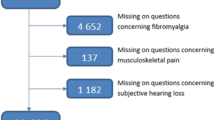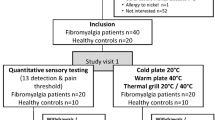Summary
We examined to what extent patients with fibromyalgia differ from painfree control subjects in the perception and processing not only of somatosensory but also of external stimuli. For this purpose the acoustic perception of 30 patients with fibromyalgia was compared with that of 36 generally pain-free age and gender matched subjects. The groups were also controlled for organic disease of pathological dysfunction of the ear and auditory nerves. Thresholds of unpleasantness and hearing thresholds were determined autiometrically for various frequencies. In addition the participants rated their experience of daily noise, vulnerability to acoustic stress, and functional and affective complaints associated with fibromyalgia. As expected the results show reduced unpleasantness thresholds for all frequencies and a nonsymptomatic hearing loss for higher frequencies. The elevated hearing threshold correlated significantly with experience of noise at the place of work, which was also elevated in the fibromyalgia group. Generalized pain had a high impact on the interaction between threshold of unpleasantness and daily noise experience. We interpret the differences in thresholds of hearing and of unpleasantness in patients with fibromyalgia as a form of either pre-conscious or conscious acts to protect against disturbing stimulation. Our results support the notion of a generalized disturbancy of perceptual thresholds in patients with fibromyalgia not restricted to the perception of pain.
Zusammenfassung
Es wurde geprüft, inwiefern sich Fibromyalgiepatienten nicht nur in der somatosensorischen, sondern auch in der Wahrnehmung und Verarbeitung externer Reize von Kontrollprobanden ohne generalisierte Schmerzen unterscheiden. Dazu wurden 30 Fibromyalgiepatienten mit 36 überwiegend schmerzfreien Kontrollprobanden hinsichtlich auditiver Wahrnehmungsleistungen verglichen. Die Gruppen waren nach Alter und dem Ausmaß hörorganisch nachweisbarer Schädigungen parallelisiert. Audiometrisch wurden Aversions- und Hörschwellen bestimmt. Zusätzlich machten die Teilnehmer Angaben zur Lärmerfahrung im Alltag, zur Vulnerabilität für Lärmstreß und zu fibromyalgieassoziierten Beschwerden. Die Ergebnisse zeigen bei Fibromyalgiepatienten die erwartete frequenzunabhängig reduzierte auditive Aversionsschwelle sowie im oberen Frequenzbereich einen asymptomatischen Hörverlust. Als gruppenübergreifend signifikantes Korrelat der Hörschwellenerhöhung erwies sich die selbstberichtete Lärmerfahrung am Arbeitsplatz, die bei Fibromyalgiepatienten erhöht war. Die Bewertung von Alltagslärm kovariierte ebenso wie die bewertungsabhängige auditive Aversionsschwelle mit der klinischen Schmerzausdehnung. Aversions- und Hörschwellendifferenzen werden als zwei Formen vorbewußter oder bewußter Methoden der Reizabschirmung bei Fibromyalgiepatienten interpretiert. Die Ergebnisse sprechen für eine nicht nur schmerzspezifische Störung der Reizverarbeitung. Erhöhte multilokuläre Druckschmerzhaftigkeit bei Fibromyalgie kann als eine von mehreren Manifestationen einer durch allgemeine Schwellenveränderungen und reduzierte Differenzierungsfähigkeit gekennzeichneten Reaktion auf externe Stimulation verstanden werden.
Similar content being viewed by others
Author information
Authors and Affiliations
Additional information
Received: 26 May 1997 Accepted: 22 October 1997
Rights and permissions
About this article
Cite this article
Dohrenbusch, R., Sodhi, H., Lamprecht, J. et al. Fibromyalgia as a disorder of perceptual organization? An analysis of acoustic stimulus processing in patients with widespread pain. Z Rheumatol 56, 334–341 (1997). https://doi.org/10.1007/s003930050047
Issue Date:
DOI: https://doi.org/10.1007/s003930050047




